- Benefits of using it
- Yoga strap types
- Yoga Strap Stretches
- Shoulder
- Hamstring
- Lower back
- Hips
- Neck
- FAQs
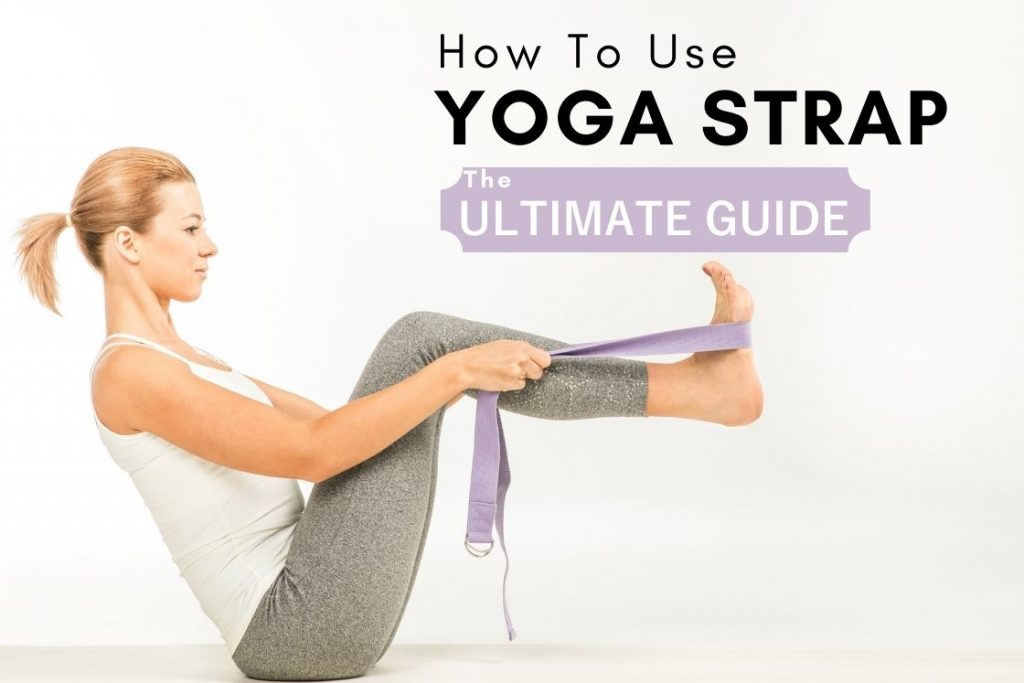
Using props and supports in yoga is a common practice. While there is a separate set of yoga styles such as Iyengar, Restorative, and Yin that use yoga props, using support in other traditional yoga forms is also seen frequently. One such prop is a yoga strap.
A yoga strap is a long woven lengthy belt that usually comes with a buckle at one end and another end is empty. It’s mainly used for stretching, alignment and increasing the range of motion in a pose, hence a strap can enhance your yoga practice up to great extent.
The strap is usually made of cotton, hemp, or can be of any other material and is generally 6 to 9 feet long. They come in various colors and varieties to suit the practitioner’s preference.
You can tailor the length of the strap as per the pose, mimic the lengthening of the arm, help in better asana alignment, provide relief from tension in various body parts, and also enhance relaxation.
Apart from the above, they offer a variety of benefits, which we will discuss in the next section.
Benefits of using Yoga Straps
It is interesting to know that yoga straps can be used by anyone, irrespective of them being a beginner or an advanced level practitioner.
Beginners may need to use them as support or when they are unable to reach their toes or hold their hands the back, for example. Advanced practitioners can use them to take an asana to the next level by increasing their body movement or going into a deeper stretch.
For people with tight hips and hamstrings, yoga straps will be beneficial to use in seated asanas. A looped yoga strap can help you with some balancing poses or it can also be used to keep your knees or elbows in line. There are a number of ways through which you can create variations in your asanas using a yoga strap.
Let us look at some benefits a yoga strap can provide.
- Using a strap mimics an elongated arm and helps you reach body areas that are inaccessible. If you’re trying to hold your toes in a seated or balancing pose, putting your feet in a looped strapped can help in putting the leg in a better position.
- If you’re a beginner and are having trouble in alignment and getting the correct posture for an asana, a yoga strap can be of great help. You can use them to keep your back straight by pulling your shoulders back.
- When you use a yoga strap, you can increase the effectiveness of a stretch. You will be able to open your body and make yourself flexible enough for more advanced poses.
- It helps in building resistance and endurance so that you will be able to hold the poses for a longer duration.
- You can use yoga straps to perform some warm-up poses to prepare your body for your yoga session.
- A balanced and stable abdominal area is necessary to maintain any asana which requires balance or core strength. If you keep the yoga straps under the soles and pull them with your arms, it will ease any tension in the abdominal area.
- By using yoga straps, you will be able to hold poses for a longer duration and put less strain, which gets you relaxed and enjoy the benefits of the pose.
- You will have more awareness of the problem areas of the body with the enhanced stretching sensation by using a yoga strap. It makes you aware of how a particular pose works on a muscle, joint, tissue, etc, which you may ignore otherwise.
- People with tight hips, hamstrings, and back pains can be benefitted as it releases the stress causing the pain. Also, you can avoid curving your spine in many seated or bending poses by using a yoga strap.
Different types of yoga straps you can choose from
1. Simple Yoga Strap (with no buckle or ring)
The first type of yoga strap is the one with no metal or plastic ring or buckle attached to any of its ends. They are mostly used by beginner practitioners as they are quite easy to handle. The buckle or belt sometimes creates a lot of sounds which may disrupt the silence and serenity of the yoga class.
These belts are handy and easy to use as compared to their other counterparts. Some people find looping through buckles and ring a complex activity, hence simple yoga straps are best suited for them. And since you are creating a loop by yourself, you do not have to adjust the strap repeatedly and interrupt your yoga practice.
However, if you do not tie the loop properly beforehand or it is not adjusted as per your need, you will be practicing your yoga poses with incorrect alignment. The knot of the loop should be adequately fastened, which may take some time to learn.
2. D-ring Yoga Strap
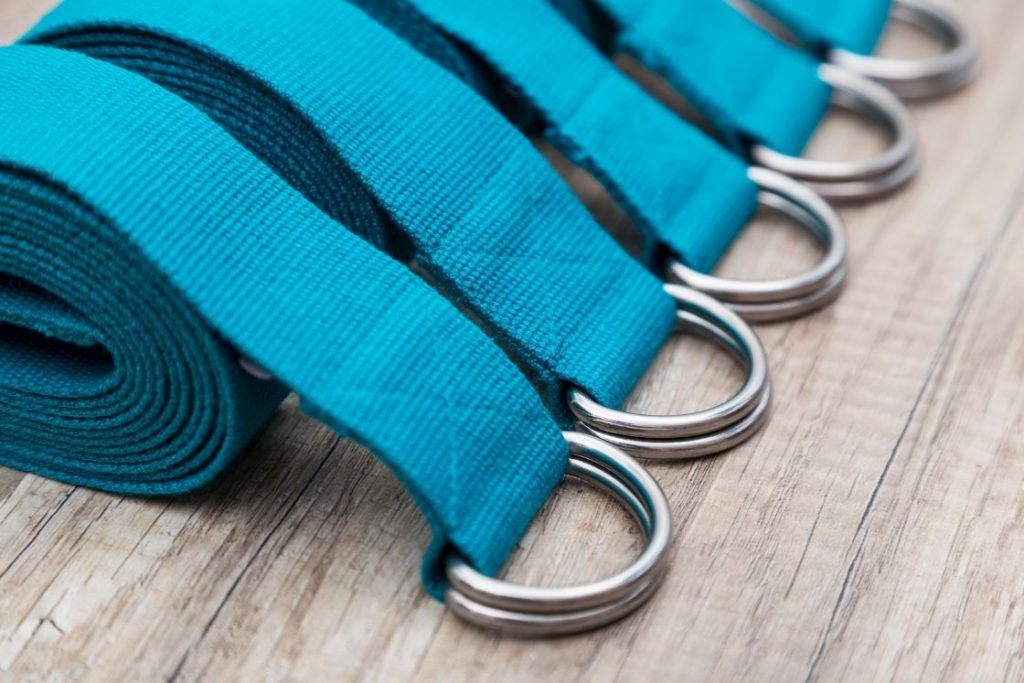
As the name suggests, this type of metal strap comes with a metal ring, in the shape of a “D” buckle attached to its ends. It is one of the commonly used yoga straps in yoga classes. In a typical D-ring strap, there are two metal D-rings on one end and another end is empty. The empty end is used to thread it through the D-rings to make the desired loop.
You need to prepare your D-ring strap before the class begins. Take the empty end through both loops and then fold it over itself. This empty end will now be on top of the rings. You should now take this non-ringed end through one D-ring to tighten the loop.
This type of yoga strap is quite useful when you want to adjust the loops based on your pose or the body part you want to work on. You can also use it to keep your back straight and maintain proper posture during poses. It is most beneficial for tall people or those who want an extended arm length.
Make sure you have a well-prepared belt. If the loops loosen or come undone in the middle of a pose, it can cause serious injury.
3. Cinch Buckle Yoga Strap
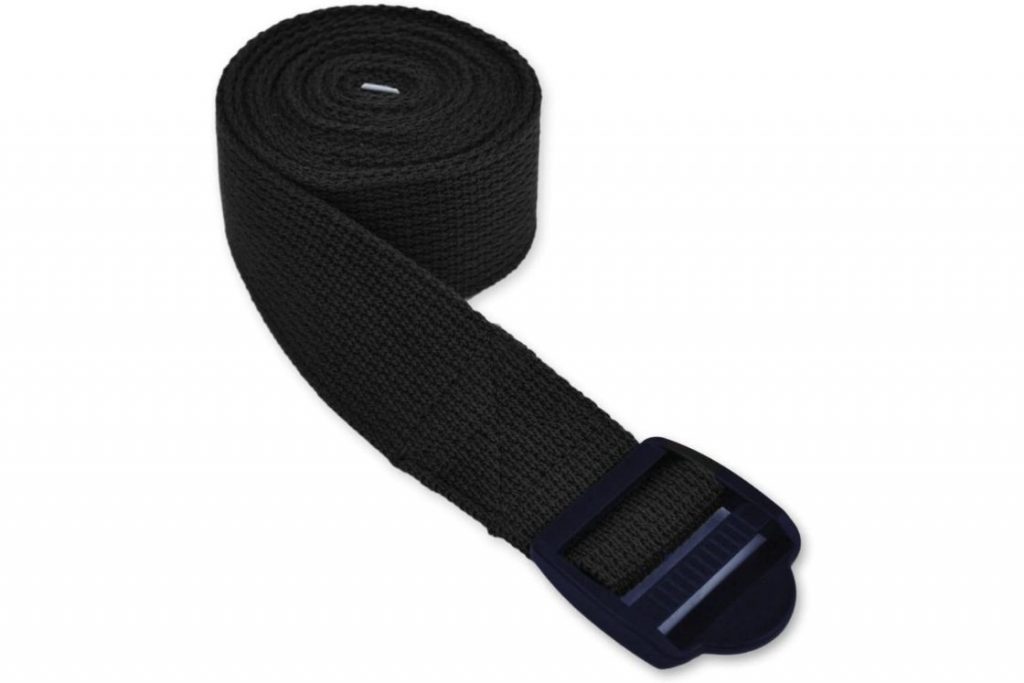
You must have seen these buckles on the straps of school bags. They mostly come in plastic but their metal variants are also available. A cotton yoga strap with a cinch buckle is another popular choice among yoga practitioners.
It is easy to use with one hand, which means you can adjust your loops without disrupting your pose. The plastic cinch buckles are considered sturdy as the empty end of the strap gets tightly gripped to the anti-slip cinch.
4. Pinch Buckle Yoga Strap
You must be familiar with the black plastic buckle where one end is hollow and the other is like a pitchfork. The pitchfork goes into the hollow buckle and with a satisfying “click” sound, you know you have secured the belt. You can adjust the belt with one hand, without having to move away from your pose to disconnect the buckle.
The plastic buckles hold the straps tightly in their grooves, hence you can be assured that your straps will not come undone mid-pose.
Yoga strap stretches and poses
Yoga straps can be imbibed in many poses and simple stretching exercises to help you touch your toes, stretch the shoulders, work on hamstrings, or gain more flexibility.
We have listed some poses and stretches that can be practised by using yoga straps.
Yoga strap stretches for shoulders
People who have desk jobs will know how shoulders feel strained after having been hunched on a laptop or desktop the entire day.
Using a yoga strap will help in releasing the tension from the shoulder blades making you feel as if a huge weight has been lifted from your shoulders and upper back.
1. Shoulder strap circles
This shoulder stretch can be done anytime and whenever you feel stiffness in your shoulders or upper back.
By using a simple yoga strap (with or without buckle), you will be able to keep your hands straight & stable and adjust the space between the arms.
To practice shoulder stretch with yoga strap;
- You can either sit in a Vajrasana or stand straight.
- Stretch your arms in front of you and hold a yoga strap in your hands. Your arms should be spread more than shoulder-width apart.
- For 5-6 seconds, hold the arms in front of you. Then slowly, take them above your head and hold them there for 5-6 seconds.
- Then, take them towards the back as far as you can. Initially, it might be difficult but take them back only to the point where you feel a nice stress-relieving strain. If you start feeling discomfort, slowly bring them back on top of the head or adjust the space between your arms.
You can keep adjusting the arm position as per your comfort level. Pause longer at the points you feel need more focus. And at no point should you be bending your shoulders as it loses the purpose of the stretch.
2. Cow Face Pose
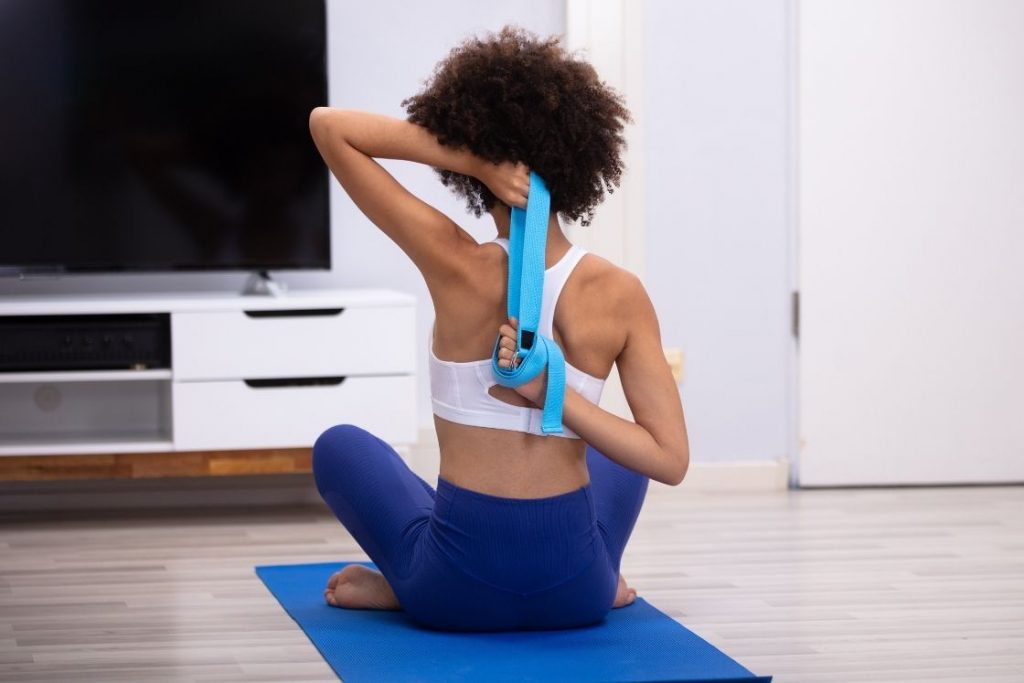
This pose is effective in stimulating all your focal points such as ankles, hips, elbows, shoulders, and chest. However, in the case of tight shoulders, the Cow Face pose is extremely beneficial. As you are stretching your arms behind your back, you need to clasp them to release stress from your shoulder and shoulder blades.
Interestingly, for some people, clasping hands behind the back in cow face pose is much easier done with one side than the other. In such a situation, a yoga strap can come to your rescue. You can use it to shorten the distance between the hands. Instead of holding your hands, you just need to hold the straps and adjust the distance between your hands to increase or decrease the stretch.
Using a strap in this pose is also beneficial for new practitioners. It will help them develop their strength and flexibility in their shoulders over time.
- Sit in Dandasana with your spine straight. Bend your knees with your feet on the floor.
- Gently bring your left leg under the right leg so that the left knee comes directly under the right knee. Cross your legs such that the right foot is placed on the outside of the left hip and vice-versa.
- Your heels should be equidistant from the hips, for that you may have to adjust the right foot as it is on the top. Sit comfortably and evenly on the sitting bones.
- Hold a strap in your left arm and lift it over your head. Bend them to bring your hand to the back of the neck. Bring your right arm out on the side and bend them to bring your hands to your mid-back.
- Instead of clasping your hands, hold the straps with your hands. Line your elbows towards the center and rest the back of your head on the left arm to keep it straight.
- Stay in this position for 5 breaths. Release the straps and perform the same with the opposite side.
You can work with the straps by adjusting the hold. Gradually keep bringing your hands closer or further as per the level of stretch you want. You can also pull the straps up and down to move your shoulders.
Yoga strap stretches for Hamstrings
Tightness or stiffness in the hamstrings can cause reduced mobility, flexibility and cause aches, which can also affect your posture. Using straps in seated and standing yoga poses that involve stimulation and stretching of hamstrings can be beneficial in getting the required relief.
1. Seated Forward Bend
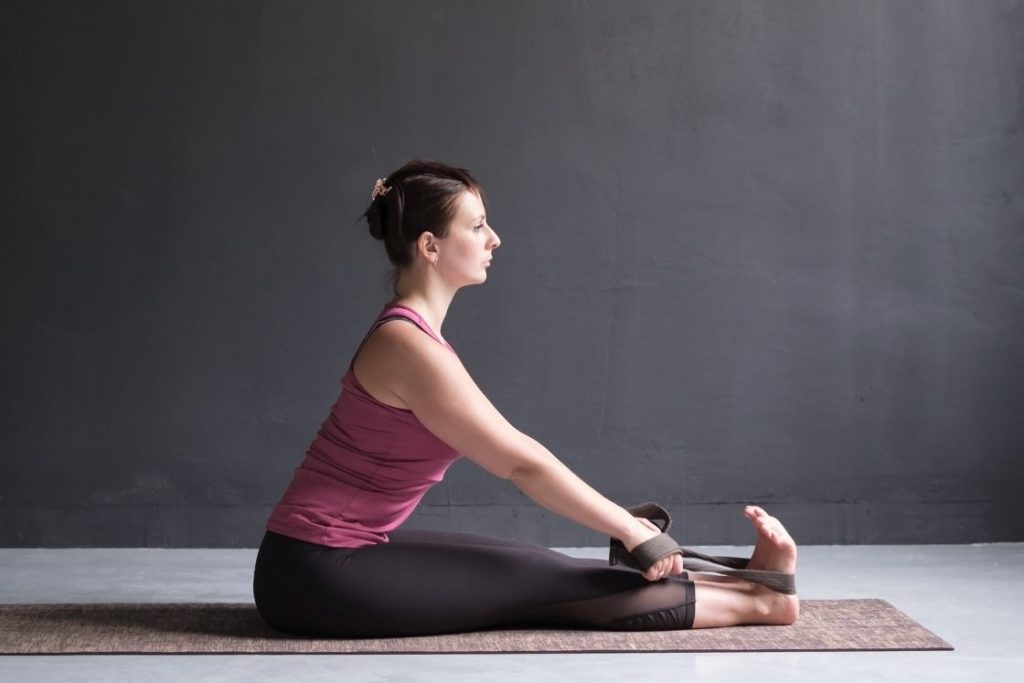
Most seated poses involve the use of hamstrings as you have to stay stable, keep your legs straight and use your hips to bend forward. Seated Forward Fold (paschimottanasana) is one such asana that provides a wonderful hamstring stretch. However, due to incorrect alignment of knees and spine, this stretch is reduced.
By using a yoga strap, you can easily deepen the hamstring stretch in seated forward bend as you will be able to keep your legs straight without a knee bend. You will not be required to bend as much as you would have without a strap.
- Sit on a yoga mat and bring your feet towards you to place the loop of the strap at the balls of the feet.
- With a straight back, start straightening your legs to the front and keep flexing your feet. When you have completely straightened your legs, stay in this position to find a comfortable hold.
- Holding the strap with both hands, gently bend forward. You do not have to bend completely, just go as far as you feel a comfortable stretch in the hamstrings.
- Stay in this pose for at least 5 breathes or as long as you can.
The same process can be followed in the Head-to-knee pose (Janusirsasana) for a hamstring stretch.
2. Reclined Hand-to-Big-Toe Pose
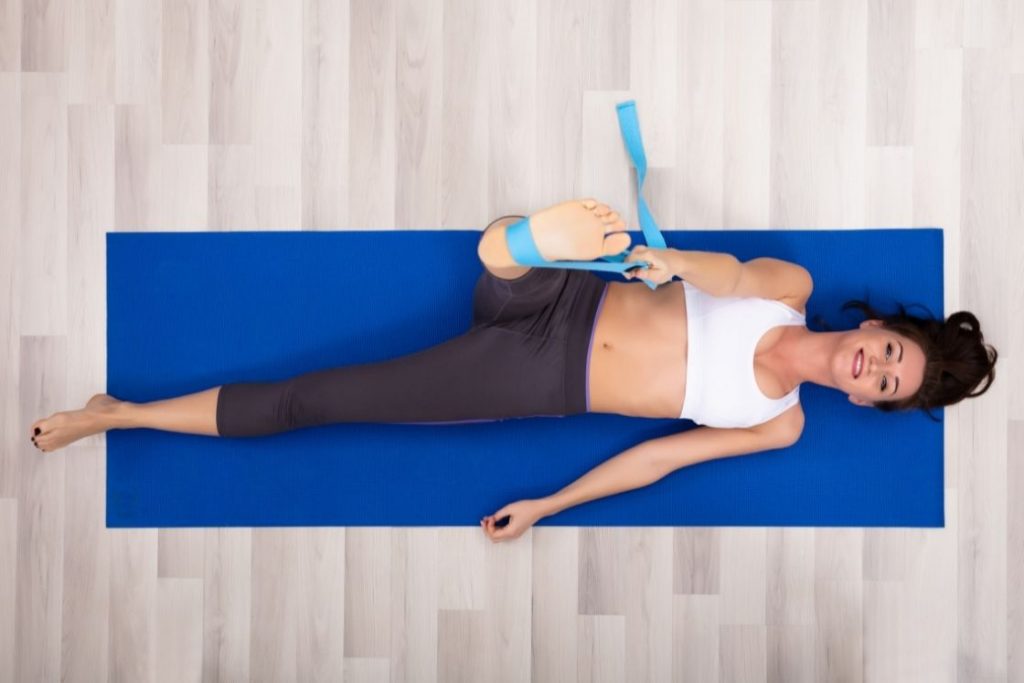
Typically a standing pose, this pose tests your stability and core strength, while stretching your hamstring and opening your hips. This pose is also good to test your flexibility. In the reclined version, it becomes restorative.
In reclined hand-to-big-toe pose, you may curve your spine to touch your toes, which can cause a strain on your neck, shoulders, and back. Use a yoga strap to increase your arm length and keep your back straight. It will also help in effectively increasing the hamstring stretch by avoiding bending of the knees.
- Lie down on your back and bend the right knee to bring the right foot closer to the chest. Place the loop of the yoga strap on the balls of the foot and tightly hold the straps at both hands.
- Slowly, straighten your foot towards the ceiling. Your right leg should now be perpendicular to the floor.
- Hold this position for 5 breaths or as long as you want and repeat with the other leg.
To enhance the stretch, you can lower the extended leg to the same side by holding the strap with one hand.
Yoga strap stretches for Lower Back
Apart from the hips, your lower back also takes the immense strain of your weight. People often complain of lower back pain which can be caused to incorrect posture, constant bending while sitting or stiff muscles. Using yoga straps can aid in deepening the stretch in back bending or hip opening poses.
1. Bow pose
The bow pose is a deep backbend pose that opens your chest, stretches your hamstrings, and engages the entire back. However, if you are just learning this pose, you will have difficulty holding your toes or even taking your arms back.
Through yoga straps in bow pose, you will be able to substitute the length of your arm and also be able to adjust the stretch. You will be able to gently move into the pose by using yoga straps.
- Place the yoga strap in “U” form such that your shins will rest on the U bend and both the ends of the strap reach your hands. Lie down on your stomach and hold the strap with both hands.
- Keep your legs hip-width apart, bend your knees and flex your feet so that the strap is now on the ankles. Take some time in this pose and then start moving your hands on the strap to bring them as close to the feet as possible.
- Bend your knees more so that your heels are near the buttocks. Hold this pose and then slowly start extending your lower legs away from your buttocks. Simultaneously, your hands will also be moving up along with your shoulder, head, and chest.
- Stretch your soles towards the ceiling so that your knees and most of your thighs and hips are off the floor. Your navel, pubic bone, and hips points will remain in the ground. Keep your gaze upwards but do not extend your head backward.
- Hold this pose for 5 breaths.
2. Bound Angle Pose
This pose comes under the group of hips openers. However, for this seated hip-opening pose to be effective, your back needs to be straight, especially your lower back. If your lower back is stiff, you may not be able to practice the pose with the correct alignment.
Hence, the yoga strap will help you in giving support to the lower back and keeping a straight spine. It also enhances the stretch of the hamstrings and encourages you to pull your feet inwards.
- Start by sitting in Dandasana. Bend both your knees and bring the soles of the feet together to join them.
- Here you need to wrap the yoga strap around your lower back and bring both ends in front of you. Take the strap under your feet and tighten them as per your comfort level. Over here using a buckle strap would be helpful.
- Place your hands on the knees in a mudra of your choice or with palms up.
- Now you can adjust the space between your feet and your groin to increase or decrease the stretch.
- Make sure all this while your spine has been straight with the strap supporting your lower back.
- You can stay in this pose for as long as you want.
Yoga strap stretches for Hips
It is said that stress from traumatic incidents, your work, or stress, in general, gets accumulated in the hips. And since ups and downs are a part of life, imagine the amount of tension they have been holding. This stress can flare up in form of stiffness or pain.
Poses where you open your hips or stretch them are a great way to release this stiffness. And with the addition of a yoga strap, you can increase your flexibility in holding the stretch for a longer duration.
1. Tree Pose
The tree pose is counted amongst some of the difficult poses as you have to balance your entire body on one leg. Your core and back should be extremely stable and strong to hold this pose. Moreover, it is also a great hip-opening pose.
When a student has been introduced to this pose, they may often find it difficult to keep one leg supported on another. And there are often chances that you are unable to place your feet on the inner thigh, instead, you keep it lower or the knee. This may not give the required stretch to the hips and can be a cause of discomfort to the supporting knee.
A yoga strap will help you maintain the support and also adjust the leg position as you progress.
- Stand in Tadasana with legs hip-width apart.
- Create a loop on one end of the strap and place your left foot in it. Adjust the loop so that it wraps around tightly yet comfortably on the middle of the left foot. Hold the rest of the strap with your left hand.
- Putting weight on the right leg and using your core, slowly pull up the strap to lift your left leg towards your chest.
- Keeping the same pace, turn your left sole inwards and place it on the right inner thigh. If you are new to the pose, you can place your left foot on the right lower knee. You can keep bringing up your left foot as and when required with the support of the yoga strap.
- Hold this pose for a minimum of 1-2 minutes.
2. Triangle Pose
The triangle pose works on your stability, flexibility, and lower body strengthening. It engages your hips, groin, hamstrings, quadriceps and opens your chest and shoulders. Most practitioners, especially beginners make the mistake of pulling the pelvis and hips forward. Due to this, the alignment of the pose gets distorted and causes a cramp or pain in the hip and pelvis areas.
Using a yoga strap will help you maintain that alignment and bring your awareness towards the pelvis. If your strap comes loose, you will automatically know that your hip was tilted forward.
- Stand in a Tadasana. Spread your feet 3 feet apart with the right foot facing the shorter end of the yoga mat and the left foot tilted diagonally. The feet should be placed in a way that the heels should be aligned.
- In this position, wrap the yoga strap around the left foot so that it is placed under the heels. The rest of the straps goes around the right upper thigh and is placed just below the joint where the leg joins the hips. Make sure the strap is tight enough.
- Now, spread your arms and keep your right arms in front of you. Lower the right arm so that your hand touches your shins, ankles, or the ground. The left hand is now extended towards the ceiling.
- Your hands should be in a straight line, with your left shoulder stacked on top of your right.
- Turn your head so that you are gazing towards the tips of yoru left fingers. Hold the pose for 5 breathes and repeat with the other leg.
Pay attention to the tightness of the straps and fix your alignment accordingly.
Yoga strap stretches for Neck
Needless to say, the neck is one of those areas that suffer the most. Incorrect posture, constant work on the laptop, looking down at mobile phone, cramps, and stiffness due to incorrect sleeping posture, whiplashes are some of the reasons that can be a cause of pain or stress.
With the help of a yoga strap, you can practice some easy and effective neck stretches and exercises that will help in de-stressing the muscles and provide relief from aches. You can practice these stretches by sitting comfortably on a yoga mat, bed, at a table, or even standing.
1. Stretch #1
Place the middle of the yoga strap at the base of your head. Hold the straps with both your hands and extend your arms forward.
Move your head forward and backward just like you would in Egyptian dance but in a gentle manner. Keep your shoulder relaxed to put less strain on your arms.
Do this movement for at least 1-2 minutes.
2. Stretch #2
Place the middle of the yoga strap at the right side of the head, just above the right ear.
Bend the left arm so that it forms a 90-degree at the elbow and hold the yoga straps.
Now, gently move your left forearm up and down to pull your head sideways. Do this movement for 1-2 minutes and repeat it on the other side.
Conclusion
It is safe to say that straps can be used in multiple ways. Before using the straps, learn from an instructor to get the correct way of tying the loop and their placement. You can either use it as a support, to adjust your alignment, deepen or soften the stretch, or focus on a specific area. These straps come in many variations hence choose as per your requirements.
Yoga straps will help you lessen the stress from your muscles and give the required relaxation.
Frequently Asked Questions on Yoga Strap
In a D-ring strap, take the empty end through both loops and then fold it over itself. This empty end will now be on top of the rings. You should now take this non-ringed end through one D-ring to tighten the loop.
A cinch buckle has a divider which creates 3 sections/slots. Take the empty end of the yoga strap thread it from the inner section. Bringing the strap end over the divider, push the empty end into the outer section. You can loosen or tighten the loop using the empty end that you have pushed into the various slots.
Typically, there are 3 variants available – 6-feet, 8-feet, or 10-feet. The 6-feet yoga trap can be used for all yoga asanas and is most preferred by beginners. However, if you are quite tall, you will need the 8-feet or 10-feet variant, depending on the availability.
Yoga straps often come in cotton material which makes them easily washable. Use cold soapy water to soak them or wash them in a washing machine. Instead of putting them in the dryer (to avoid shrinking), hang them to dry. Do not leave them to dry in a damp place or else they can get moldy.
The basic difference between the two is that a yoga strap is for support and can be adjusted. A resistance band, as the name suggests causes resistance to your movement, just like a rubber band.
Yoga straps are made from cotton material whereas resistance bands are made from stretchy rubber material which causes pushback.
Resistance bands can offer light to heavy resistance. In a yoga belt, you create a loop to adjust your pose or stretch and it provides no resistance at all.
The post How to Use a Yoga Strap + Stretching Exercises You Can Do With It appeared first on Fitsri.